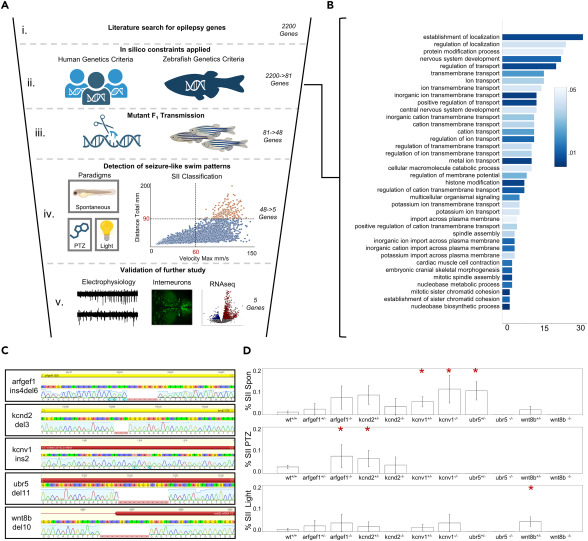Fig. 1 Overview of evaluation of candidate human epilepsy genes in zebrafish models (A) Graphical depiction of primary F2 screening method including: (i) initial gene identification through literature search; (ii) application of in silico constraints; (iii) generation of initial crispants and stable F2 mutants; (iv) detection of seizure-like swim patterns in either a spontaneous, light-provoked, or subthreshold PTZ assay; and (v) characterization of mutant lines that displayed SII seizure events via local field potentials, quantifying dlx-GFP expressing inhibitory interneurons and RNA-seq. (B) 48 genes for which we generated surviving crispants and stable mutant lines represent heterogeneous Gene Ontology (GO) categories of biological processes. (C) Schematic of homozygous mutations found in the five genes meeting criteria for positive seizure-like swim patterns. (D) Results from three paradigms suggesting hyperexcitability based on swim patterns. Paradigms included a 1h spontaneous recording, a light provoked recording and a subthreshold PTZ provoked paradigm. Mutant larvae exhibited limited SI-like behavior as shown by mean velocity, but 5 mutant alleles showed an increase in the proportion of larvae with at least one SII event. Statistical significance for SI behavior was determined by Kruskal-Wallis tests with Dunn multiple comparisons while significance of SII events was determined by the binomial probability of SII events compared to the expected value from the population proportion. Significance was determined within a 95% confidence interval, ∗p < 0.05, ∗∗p < 0.01, ∗∗∗p < 0.001. Data are represented as proportional mean ± STD. Candidate gene list and information available in Table S1 . Behavior n per gene and genotype is available in Table S2 . Additional information available in Table S3 . Figure (A) was created with BioRender.com .
Image
Figure Caption
Acknowledgments
This image is the copyrighted work of the attributed author or publisher, and
ZFIN has permission only to display this image to its users.
Additional permissions should be obtained from the applicable author or publisher of the image.
Full text @ iScience

